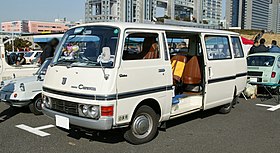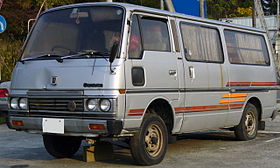Nissan Caravan
| Nissan Caravan | |
|---|---|
 |
|
| Overview | |
| Manufacturer | Nissan (Nissan Shatai) |
| Production | 1973–present (Nissan Caravan) 1965–1997 (Nissan Homy) |
| Layout | FR layout |
| First generation (E20) | |
|---|---|
 |
|
| Overview | |
| Also called | Datsun Urvan Nissan Homy |
| Production | 1973–1980 |
| Body and chassis | |
| Body style | 3-door van 4-door van |
| Powertrain | |
| Engine | |
| Dimensions | |
| Wheelbase |
|
| Second generation (E23) | |
|---|---|

Nissan Caravan (E23) LWB
|
|
| Overview | |
| Also called | Datsun Caravan/Urvan (until 1983) Nissan Homy Nissan Urvan Yue Loong Homer 747 (Taiwan) |
| Production | August 1980 – 1986 |
| Body and chassis | |
| Body style | 4-door van 5-door van/coach |
| Related |
Nissan Atlas Nissan Cabstar |
| Powertrain | |
| Engine | 1.6 L J16 OHV I4 1.8 L Z18S I4 2.0 L H20 OHV I4 2.0 L Z20S I4 2.0 L LD20T turbodiesel I4 2.2 L SD22 diesel I4 2.3 L SD23 diesel I4 |
| Dimensions | |
| Wheelbase | 2,350 mm (92.5 in) |
| Length | 4,350 mm (171.3 in) |
| Width | 1,690 mm (66.5 in) |
| Height | 1,950 mm (76.8 in) |
| Curb weight | 1,930 kg (4,254.9 lb) |
| Third generation (E24) | |
|---|---|
 |
|
| Overview | |
| Also called | Nissan Homy Nissan Urvan Nissan Urvan Escapade Nissan Urvan Shuttle Nissan Caravan Homy Isuzu Fargo |
| Production | 1986–present 2001–2015 (Philippines) |
| Assembly | Kenya: Thika |
| Body and chassis | |
| Body style | 3-door van 4-door van |
| Powertrain | |
| Engine | 2.3 L TD23 diesel I4 2.5 TD25 diesel I4 2.7 L TD27 diesel I4 2.7 L TD27T1 turbodiesel I4 3.2 L QD32 diesel I4 2.4 L KA24DE petrol I4 3.0 L VG30E petrol V6 Petrol 4.5 L V8 commercial use only |
| Dimensions | |
| Wheelbase | 2,375–2,645 mm (93.5–104.1 in) |
| Length | 4,420–5,100 mm (174.0–200.8 in) |
| Width | 1,690 mm (66.5 in) |
| Height | 1,950–2,395 mm (76.8–94.3 in) |
| Curb weight | 1,930 kg (4,254.9 lb) |
| Fourth generation (E25) | |
|---|---|

Nissan Caravan (pre-facelift)
|
|
| Overview | |
| Also called | Nissan Urvan Nissan Urvan Estate Isuzu Como |
| Production | 2001–2012 2004–2013 (Philippines) |
| Assembly | Kanagawa, Japan Zhongji Company, Luanda, Angola Kuala Lumpur, Malaysia (TCMA) |
| Body and chassis | |
| Body style | 3-door van 4-door van |
| Powertrain | |
| Engine | 2.0 L I4 (gasoline) 2.4 L I4 (gasoline) 2.5 L I4 (gasoline) 3.0 L ZD30DD I4 (diesel) |
| Transmission | 5-speed manual 4-speed automatic |
| Dimensions | |
| Wheelbase | 2,715 mm (106.9 in) |
| Length | Pre-facelift: 4,990 mm (196.5 in) Facelift: 4,995 mm (196.7 in) |
| Width | 1,690 mm (66.5 in) 1,990 mm (78.3 in) |
| Height | 1,990 mm (78.3 in) 2,285 mm (90.0 in) |
| Chronology | |
| Successor |
Nissan NV (Mexico) Nissan NV350 Caravan (Japan) |
| Nissan NV350 Caravan (E26) | |
|---|---|
 |
|
| Overview | |
| Also called | Nissan NV350 Urvan Isuzu Como Mitsubishi Fuso Canter Van |
| Production | 2012–present |
| Assembly | Japan: Kanda, Fukuoka, Kyushu (Nissan Shatai) |
| Body and chassis | |
| Body style | 4-door van |
| Powertrain | |
| Engine | 2.5 L YD25DDTi engine 2.0 L QR20DE engine 2.5 L QR25DE engine |
| Transmission | 5-speed Automatic 5-speed Manual |
| Dimensions | |
| Wheelbase | SWB: 2,555 mm (100.6 in) LWB: 2,940 mm (115.7 in) |
| Length | SWB: 4,695 mm (184.8 in) LWB: 5,080 mm (200.0 in) |
| Width | 1,695 mm (66.7 in) |
| Height | Low roof: 1,990 mm (78.3 in) High roof: 2,285 mm (90.0 in) |
The Nissan Caravan is a van designed by Nissan for use as a fleet vehicle or cargo van since 1973. Between 1976 and 1997, a rebadged version of the Caravan sold as the Nissan Homy, which was introduced as an independent model in 1965. Outside Japan, the Caravan was sold as either Nissan Urvan, Nissan King Van, or Nissan Homy.
Prior to 1973, the Caravan's twin, the Homy had been offered as a standalone generation from 1965 until 1976. The Homy was built and sold by the Prince Motor Company before the merger of Nissan in 1965 and the Homy was the first vehicle to be acquired by Nissan. After the merger in August 1966, the Prince Homy name was changed to Nissan. The merger was complete by 1970. It shared a chassis with the Prince Homer, a small pickup truck.
The second generation Homy of 1976, was marketed as a twin to the 1973-era Nissan Caravan, sold at the Nissan Prince Store dealerships, while the Caravan was exclusive to Nissan Bluebird Store locations. The first generation series B640 which was changed to Nissan series T20 was built from 1965 to 1976, the second generation E20 was built from 1976 to 1980, and the third generation E23 was built from 1980 to 1986. The final generation E24 was built from 1986 to 1999, and replaced by the Nissan Elgrand. Mechanically, the Nissan Caravan and the Nissan Homy were identical. Its traditional competitor from Toyota is the HiAce. Nissan's largest passenger van is the Nissan Civilian, introduced in 1959.
The Prince Homy (B640) had a seating capacity of up to 15 people. In 1966 as the Prince-Nissan merger began, it was initially called the Nissan Homy Prince, and the Prince name became a dealership network in 1970. The Nissan Homy received the T20 model code. In 1972, the vehicle was reclassified as a commercial vehicle, in order to comply with the 1970 Japanese road traffic law. Nissan did not have a companion vehicle for the Homy, so from 1973 the Homy was also available rebadged as the Nissan Caravan.
The E20 series Caravan and Urvan van and minibus were manufactured from February 1973 with seating configurations for three, five, seven, and up to 10 passengers. It was exclusive in Japan to Nissan Bluebird Store, while its twin the Nissan Homy was exclusive to Nissan Prince Store locations. It was especially popular in Europe, and was again very popular with fire departments and as ambulances in certain countries. It had a somewhat difficult handling, as it was heavy to steer, and was not available with power steering. Also, the gear shifter was located at the floor and went all the way up to the height of the hand, and had a slight curve. The gear shifter was nearly 80 cm (2.6 ft) long, so it was somewhat clumsy to shift, but it came with five gears, unusual in Europe at that time. It was delivered with a 1.5- and 2.0-liter petrol engines, as well as a 2.2-liter diesel unit. It was produced until replaced by the E23 Caravan in August 1980.
...
Wikipedia
